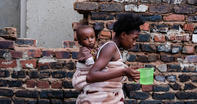Policy to Stop Breastfeeding
In the early days of the HIV pandemic, breastfeeding became taboo due to the risk of the child becoming infected with the virus through the mother’s milk. In South Africa, the Department of Health’s policy was to counsel HIV mothers not to breastfeed, instead giving them breast milk substitutes – formula – through clinics and government hospitals.

What state technocrats could not have known when they were drafting this policy is what happens when a mother is sitting in a taxi with a wailing infant on her lap and people around her say, ‘Feed your baby’. But she cannot because she does not have a sterile bottle with her and she cannot breastfeed – so she is announcing to the world she has the virus.
Nor could they have known what it would mean for a mother to carry her groceries home with the loud orange formula packaging glaring out through a plastic bag hanging from her hands, another signal to the world: here walks an HIV-positive mother.
Breastfeeding is the Best and Safest Option

What was probably more startling about the call to stop breastfeeding was that instead of reversing the rate of infant deaths, this policy accelerated them.
By August 2011, health minister Aaron Motsoaledi announced a reversal of the policy in line with the World Health Organization’s (WHO) recommendations for a ‘single feeding strategy’.
The evidence is in: yes, breastfeeding is a pathway for transferral of HIV from mother to child (as many as a third or even half of all infant HIV infections in Africa are attributed to breastfeeding up to the age of two without interventions, according to the Department of Health), but it is still the best and safest feeding option for infants under the age of six months.
Breastfeeding vs Formula for Infant Health
Even though breast milk can deliver the virus to the infant, exclusive breastfeeding results in significantly fewer post-natal mother-to-child HIV infections than when a mother combines breastfeeding with formula and other solids. This could have something to do with the fact that gastrointestinal inflammation, caused by contaminated food or fluids, leaves the lining of the infant’s gastric system susceptible to penetration by HIV.
Exclusive breastfeeding bolsters the health of the gastrointestinal tract, but it also promotes breast health in mothers, meaning less likelihood of mastitis or breast ulcers, according to the Department of Health. Formula powders are not always ‘commercially sterile’, according to the department, and can be contaminated with E. coli and Salmonella, which could lead to infection in infants.
And it is not always possible for mothers to ensure they have sterile bottles and water, particularly those living in poorer contexts with limited access to electricity and clean running water in the home. But bear in mind, in cases where women cannot breastfeed, specific guidelines are in place to encourage best practice on formula feeding.
Correct medication during breastfeeding – where both mother and infant take antiretrovirals – will lower the risk of the virus jumping across to the infant, but will facilitate the infant getting the best nutrition it can get during its first six months outside of the mother’s womb.
Optimal Nutrition During Lactation

There is also substantial evidence to suggest that exclusive breastfeeding in those first six months could help avoid problems of obesity, cardiovascular disease and certain cancers later in life, according to the WHO and the Food and Agriculture Organization.
It has also been shown to improve a person’s educational levels and cognition. Given that over half of the deaths in children under age five are linked to lack of ‘optimal breastfeeding’ and malnutrition, the Department of Health maintains that breastfeeding ‘is a key child survival strategy in resource-poor countries’.
And then there is the matter of having a well-nourished mother. The 2008 Copenhagen Consensus recognised that ‘young children’s nutrition depends critically on the nutritional status of their mothers during pregnancy and lactation’.